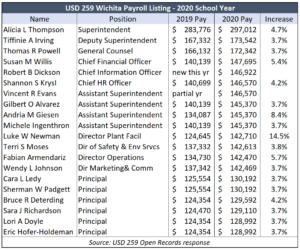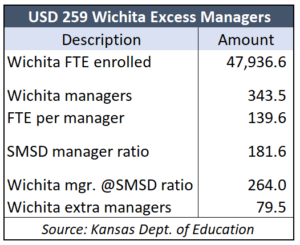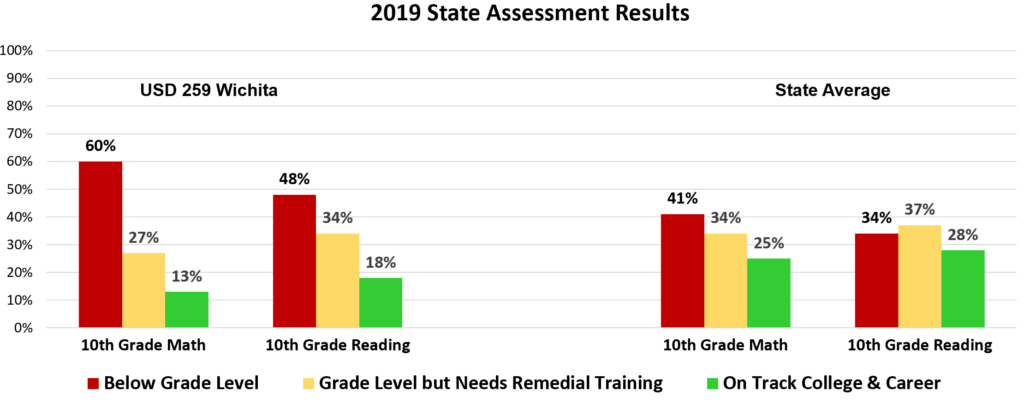The Kansas education tradition – suing taxpayers on the pretense of not having enough money to educate students but not spending the court-ordered windfall to improve student achievement – was perpetuated by the Wichita school district last year. Payroll spending on non-teachers rose faster than for teachers, non-teacher employment increased by 206 jobs while teacher employment was flat, and student achievement remains abysmally low.
An Open Records request form Kansas Policy institute, the Sentinel’s owner, shows money spent on teacher pay increased 2.6% last year, but pay for non-teachers rose 4.3%. Part of the non-teacher increase is attributable to hiring more non-teachers, but some of the district’s top management also receive sizeable increases.
 Superintendent Alicia Thompson received a 4.7% increase of more than $13,000 to a total of $297,012 last year. Deputy Superintendent Tiffinie Irving was paid $173,542, or 3.7% more, and the four Assistant Superintendents each made more than $145,000.
Superintendent Alicia Thompson received a 4.7% increase of more than $13,000 to a total of $297,012 last year. Deputy Superintendent Tiffinie Irving was paid $173,542, or 3.7% more, and the four Assistant Superintendents each made more than $145,000.
The Director of Plant Facilities, Luke Newman, was paid 14.5% more, at $142,710, and the Director of Operations, Fabian Armendariz, got a 5.7% increase to $142,470.
The complete Wichita district payroll listing is available on KansasOpenGov.org.
Top-heavy management
Having a Deputy Superintendent and four Assistant Superintendents is symptomatic of the district having more managers per student than other districts.
 The Wichita school district employed 343.5 managers last year, including the superintendent, assistant and deputy superintendents, principals, assistant principals, directors, instruction coordinators, and curriculum specialists. With 47,936.6 fulltime equivalent students, that’s an average of 139.6 students per manager.
The Wichita school district employed 343.5 managers last year, including the superintendent, assistant and deputy superintendents, principals, assistant principals, directors, instruction coordinators, and curriculum specialists. With 47,936.6 fulltime equivalent students, that’s an average of 139.6 students per manager.
By comparison, USD 512 Shawnee Mission, has 181.6 students per manager, and if it was staffed at that level, the Wichita school district would have 79.5 fewer managers.
But the savings could be even greater. Shawnee Mission has expanded its management staff under the last two superintendents but the district had 215.4 students per manager in 2015; staffed at that level, Wichita would have 121 fewer managers and the savings would make as much as $20 million more available for instruction.
Low student achievement
While non-teaching employment is at record levels, student achievement remains abysmally low in USD 259.
The 2019 state assessment results from the Kansas Department of Education shows 60% of 10th-graders in the Wichita district are below grade level in Math; 27% are considered to be at grade level but still need remedial training to be on track for college and career, and only 13% are on track.
Results for English Language Arts – labeled here as Reading – are a bit better but still exceptionally low, with 48% below grade level. 34% are at grade level but they still need remedial training and just 18% are on track for college and career.

State average results are also much lower than parents and employers are led to believe by school districts.
41% of students are below grade level in Math, and 34% are below grade level in Reading. Only about a quarter of the state’s 10th-graders are on track for college and career.
Legislators react
Two former teachers who are now state legislators say teachers and students are shortchanged by local school boards’ decisions to funnel money away from classrooms to expand administration. Rep. Renee Erickson (R-Wichita) serves on two House education committees.
“The gap between teacher and administrator pay is widening. Dedicated teachers dig into their own pockets for classroom supplies and whatever their students need. Community members are told there’s a teacher shortage crisis due to low salaries and everyone needs to donate to schools while six-figure administrators get four and five-figure raises every year. This during a financial crisis for many families who have lost their jobs. And what do these families and community members get? Dismal academic outcomes. It’s our kids who are paying the price, and that should be unacceptable to everyone.”
House K-12 Budget Chair Kristey Williams (R-Augusta) echoed Erickson’s reaction.
“I’m always disappointed and amazed when I see our district leaders and managers take larger percentage pay increases than their own teachers — the heart and soul of the classroom.”
Most parents are surprised to learn that legislators have no input on teacher pay or other aspects of school spending. Those decisions are left to local school boards and district administrators.


